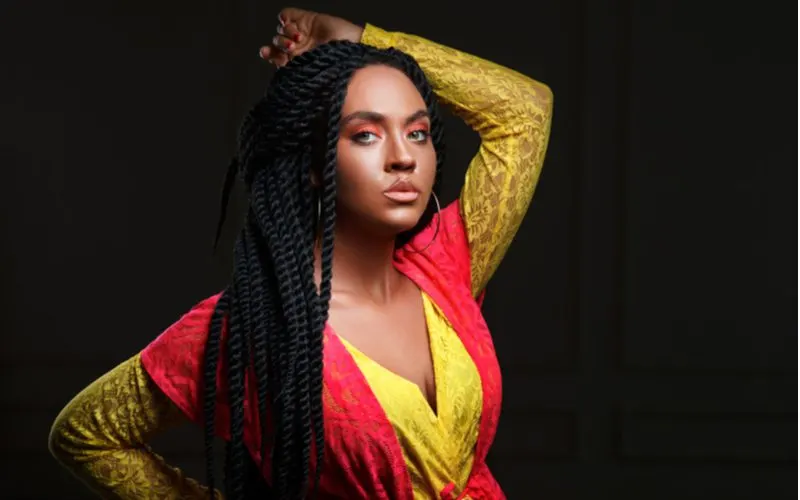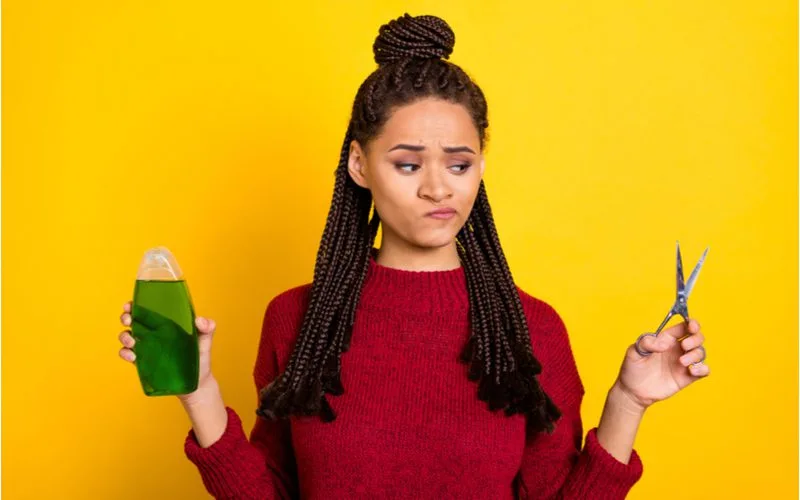Jump to:
Considering getting dreadlocks? Previously worn only by hippies, dreads are growing in popularity. So, we’ve made a complete guide to help you understand the look, what locs entail, and a few pros and cons about them.
Considering Getting Dreadlocks?
Whether you’re thinking about getting dreadlocks or just got locs, there’s a lot of conflicting info online on how to properly care for and maintain dreadlocks. In this beginner’s guide, we cover everything you need to know about dreadlocks, including:
- The different types of locs
- How to form them
- Proper care and maintenance
- Loc removal
- And more
Ever wish there was a simple class on dreadlocks that explains everything you need to know? Consider this guide Dreadlocks 101. We dive deep into this traditional hairstyle and what makes it unique.
From what dreadlocks are and their history to how to properly care for and maintain modern locs, we’ve got you covered. Here’s a quick overview of what you’ll learn:
- What dreadlocks are
- The different types of dreadlocks
- Whether dreadlocks can damage your hair
- How to maintain and care for locs
- How to remove dreadlocks
- Deciding whether or not locs are right for you
Ready to jump in? Class is officially in session!
What Are Dreadlocks?
Dreadlocks, also referred to as dreads or locs, are sections of hair that are matted and “locked” into place. Dreadlocks are typically done in small sections to create a look that is similar to hanging braids.
Dreadlocks can form irregular flat, matted sections that are wide and thin (typical of freeform dreads) or cylindrical, rope-like sections that are rounded and somewhat uniform (typical of finger coil or similar-style locs).
Dreads form naturally when hair isn’t brushed or detangled for a while. Within a year of no brushing, you’re going to see matted, dreadlocked sections in your hair. But most people that get dreadlocks have them styled and formed on purpose. There are a few methods used to “jumpstart” the matting and form uniformly shaped, cylindrical locs. We’ll cover those next.
Why Are They Called Dreadlocks?

Rikus Visser/Shutterstock
The term dreadlocks origins aren’t clear, but scholars suspect it comes from British soldiers who expressed feelings of dread and dismay upon encountering the formidable Mau Mau tribal warriors in East African, then-British-ruled Kenya.
The tribesmen wore long dreadlocks that the British soldiers had never seen before, and their battles were bloody.
The warrior’s hairstyle became synonymous with dread and the soldiers could see how the hair strands were tangled and “locked” into place. Some experts believe this is where the term dreadlocks came from.
The 5 Types of Dreadlocks
Dreadlocks can form naturally (freeform dreads) or through twisting, rubbing, or braiding methods that jumpstart the loc-formation process. Let’s take a look at the 5 general types of dreadlocks according to how they’re formed.
If you’re interested in learning how to start any of the following types of locs, check out our complete step-by-step guide here: How to Get Dreads | 4 Ways to Start Dreadlocks.
1. Freeform Locs

Freetheroots on Instagram
Freeform dreadlocks are matted locs of hair that form naturally due to friction and tangling when the hair is not brushed or detangled for long periods of time. The result is irregular locs of various thicknesses, widths, shapes, and sizes.
The process of forming freeform locs is sometimes called “the neglect method.” If you do nothing to your hair over a period of about a year, it will naturally form this type of dreadlock.
Typically, freeform dreads begin forming at the back of the head first because that’s where the most friction and rubbing happens (in bed, against the back of seats, etc.)
Freeform dreads are as authentic as it gets, but their irregularity makes them less popular than other types of dreadlocks. It also takes a while for the hair to fully loc up because you’re not following any twist or braid methods to jumpstart the process.
2. Finger Coil Locs

NatalieSchorr/Shutterstock
Finger coil dreadlocks are done using a coiling/twisting method to start the locs faster than waiting for it to happen naturally. The resulting rounded finger coils become the “base” of the dreads.
Since finger coils create hanging sections of hair that look similar to dreads, you’ll have the look of locs before the hair has genuinely matted to form true locs. This is great if you’re impatient to see how your new dreads will look!
After sectioning clean hair, each section is twisted tightly into a coil and pinned until all sections are dry. The resulting finger coils take 6 months to a year to mat into true dreadlocks.
3. Three-Strand Braid Locs

F8 Studio/Shutterstock
Three-strand braid locs use a simple braid as the base for the locs to form. After sectioning and braiding the hair, the braids are left in place for at least 6 months to allow the hair to tangle and mat into dreadlocks.
The upside of this method and type of loc is that it’s really easy and anyone who can do a 3-strand braid can do it.
The downside is that the locs formed by 3-strand braids are flatter and less cylindrical than traditional locs. If you’re looking for rounded, rope-like dreads, try the finger coil, three-strand twist, or wool rubbing method.
4. Three-Strand Twist Locs

Ukrtime/Shutterstock
While this type of dread sounds similar to the 3-strand braid locs, the method itself and the resulting locs are actually quite different. Three-strand twist locs are formed using 3-strand twists as the base of the dreads.
Essentially, 3-strand twists involve twisting each section of hair while you braid it. The result is cylindrical, rounded twists that hold the hair in its twisted pattern for weeks to months. Leaving 3-strand twists in for 2-6 months will jumpstart dreadlock formation.
After about 6 months, the twisted/coiled pattern in the twists will begin to disappear as the hair successfully mats up. The upside of using this method is that it creates attractive, cylindrical locs that are rope-like and shaped according to your preferences.
5. Wool Rubbed Locs

Rock and Wasp/Shutterstock
Wool rubbed locs are formed by creating friction and tangles in the hair with a piece of wool (hat, sweater, etc.). The wool is rubbed against the hair in a circular motion until small locs begin to form. Two things to know about this method:
- It can cause damage to your hair’s cuticle layer due to the direct friction caused by rubbing the hair with wool. Some experts recommend using this method only once to jumpstart loc formation. Others suggest skipping it entirely.
- Wool rubbed dreads will look irregular and won’t be uniform in size and shape. The locs will form according to the motions you use as you rub the wool against your head, so there’s not a lot of control over the final look.
Wool rubbed locs are an easy way to jumpstart dreadlock formation, but this is known to be the most damaging method on hair. Consider this before you choose this type of loc!
Will Dreadlocks Ruin Your Hair?
One of the most common questions we hear from people considering dreadlocks is “Will dreads ruin my hair?” Dreadlocks don’t always cause damage to your hair, but they certainly can depending on the method you use to form them and how you maintain them.
Dreadlocks are actually an example of a protective hairstyle. This means dreads secure and hold hair in a protective “shell” to prevent excess environmental, heat, chemical, and daily damage.
If you properly form and maintain your dreadlocks, they won’t ruin your hair. You can even remove dreadlocks without cutting or damaging your hair (more on that in a bit).
Retwisting or palm rolling your locs too often can cause damage to your hair, as can leaving your locs damp after a shower. As long as you ensure you fully air-dry dreadlocks and don’t over twist them, your hair will be protected from damage.
Dreadlock Maintenance and Care

Brian Eichorn/Shutterstock
Worried about misshapen, loose, dry, or stanky locs? Learning the basics of dreadlock maintenance and care will help you avoid these common problems with ease. One of the most common misconceptions about dreadlocks is that they don’t require any maintenance – just loc and go!
The truth is that while dreads aren’t as maintenance-heavy as other hairstyles, you still have to take time to maintain and care for them if you want them to look, feel, and smell their best. This starts with having the right arsenal of products, maintenance methods, and care tips.
Dreadlock Maintenance and Care Products
Keeping your dreads looking great is easier with a few basic products. You’ll need the following products to properly maintain and care for your dreads.
- Dread Tightener: Also called locking accelerator, a good dread tightening spray is key to forming and maintaining nice locs. These products force your hair’s outermost cuticle layer to open up, making the surface rougher to increase friction and accelerate matting and locking.
- Dread Cream: Moisturizing dread creams are essential to keep dreadlocks hydrated and supple while avoiding breakage and frizz. These products coat the locs in a moisturizing cream that delivers nutrients and hydration deep into your dreads. Look for one that doesn’t contain wax.
- No-Residue Shampoo: Residue-free shampoo is key for keeping locs clean. Look for formulas that don’t contain silicones, which leave a residue and buildup in the hair. You’ll need a clarifying shampoo that leaves your hair squeaky clean.
Should You Wax Your Dreads?
Dread wax is often recommended to help start and maintain dreadlocks. But wax products are actually the enemy to forming clean, shapely, and lightweight locs. Wax doesn’t dissolve in water and it’s impossible to completely remove the buildup it leaves behind.
It can also attract lint and dirt to your dreads.
Since wax isn’t water soluble, over time it will form a moisture barrier that prevents water from evaporating from your dreads (read: stinky locs). Wax can also cause dreads to harden over time. In short, don’t use wax on your dreads – ever.
How to Shampoo Dreadlocks
One question we hear a lot is “Do you have to wash dreads?” The answer to that is an emphatic YES. Shampooing dreads is essential to keep them clean and stop them from harboring bacteria, fungus, and dirt.
Shampooing dreads is recommended at least once every 2 weeks. If you are active and sweat a lot, you may want to wash your dreads at least once a week.
You can go up to 3 weeks in between washes if you’re not breaking a sweat regularly or getting your hair dirty. Using a no-residue shampoo, you’ll want to target your scalp, not your dreads, when you shampoo.
Your scalp is where the bacteria, fungus, oil, and dirt thrive. Removing all grime and buildup from the scalp will keep your dreads smelling and looking fresh. Concentrate on cleaning every square inch of your scalp, using minimal shampoo and lots of water.
Avoid sudsing up your dreads too much as the shampoo can be tough to fully remove from the locs. When you’re done shampooing, the next step is properly drying your locs.
How to Properly Dry Dreadlocks
Smelly, stinky dreadlocks aren’t a myth – it’s easy for locs to become odorous if they’re not dried fully and properly. You should never use heat to dry your locs. They’ll take so long to dry with heat that your hair is sure to sustain heat damage.
Instead, rely on air-drying to ensure all moisture is evaporated. After shampooing your dreads, squeeze them with a fully dry and absorbent towel. Cotton towels work well, but can leave lint behind in your hair.
We recommend using a good microfiber lintless towel instead. Squeeze each loc to remove as much excess moisture as possible. Once you’ve wrung out your locs with a towel, keep them separated as much as possible.
Don’t pull them up, put on a hat, or apply any product until they are fully dry. This usually takes a day or two, depending on the length and thickness of your locs.
If you’re taking a shower in between dread washes, make sure you put on a well-fitting shower cap to keep your dreads nice and dry.
Palm Rolling to Maintain Dreads
Palm rolling is a technique you should use to maintain your dreadlocks’ shape and form. It’s very easy to do and you should do it regularly, at least a few times each week. To palm roll your dreads, just take a single loc and quickly roll it back and forth in your palms.
This will help “catch” any loose hairs and reintegrate them into the loc. The friction of your palms against the dreads are what help them keep their shape and prevent them from fusing together.
How to Remove Dreadlocks

Roman Samborskyi/Shutterstock
Taking out dreadlocks is not an easy feat. With that said, it’s 100% possible to remove dreads without damaging or cutting your hair. In fact, if you’ve kept your dreads in for a few years, you’ll be surprised to see how much your hair has grown while protected in the locs.
But let’s get expectations straight. When you remove dreadlocks, you will likely experience the following:
- Hair loss due to natural shedding within the locs over time
- Frizz and brittle, straw-like hair texture
- Split, fragile ends that may need to be cut off
With this in mind, you can brush out dreadlocks with the help of a few products and a lot of patience. The longer your dreads are, the longer it will take to brush them out successfully. Many people start the brushing out process by cutting the dreads to a shorter, more manageable length.
- Saturate your locs with oil: Use your favorite hair oil (coconut, argan, olive, etc.) and completely cover and saturate every dreadlock with it. This is especially effective on cut locs where there’s an open end. If you think you’ve used enough oil, use a little more.
- Spray with water: Once your dreads are saturated with oil, use a spray bottle filled with water to spray the loc you’re working on first. Spray every few minutes as you work to keep the loc wet.
- Use a rattail comb to undo the loc: Using the pointed end of a rattail comb, start at the bottom of your dread and start poking the comb in and begin teasing the loc apart. Poke the center of the loc near the end and wiggle it downward gently to begin undoing the loc. Comb through with the comb end and add a little more oil to the combed-out portion. Move upward to the roots as you untangle the hair. Repeat for every dreadlock – this is the part that takes a lot of time.
- Braid the free hair. Keeping your de-locked, freed hair in braids will make it easier to manage as you work. It’s also going to help give you a more homogenous hair texture when you’re finished.
- Shampoo and deep condition: After combing out all your dreads, you’ll need to shampoo and deep condition your hair to restore it back to health. This will be a big moment for you if you’ve had dreads for a while! Your scalp will feel so free and clean. You will need to shampoo at least twice to remove the excess oil used to comb out your dreads. Do a deep conditioning treatment or use a leave-in conditioner to continue feeding your strands much-needed moisture.
- Do a final cut: After combing out your dreads, you’ll likely find that some of the ends are still straggly or split. Getting an inch or more cut off the ends will really polish the look and give you that healthy, vibrant hair with lots of movement that you want.
If your hair is short or you don’t mind starting over fresh, you can also remove dreads by cutting them off with clippers or scissors close to the root.
Should You Get Dreadlocks?

Natalia Lebedinskaia/Shutterstock
We’ve covered a lot in this dreadlock 101 lesson. From defining and explaining what dreadlocks are to step-by-step instructions on removing them, you’re now well-informed about this traditional hairstyle, how to care for it, and what makes it so unique.
If you’re thinking about getting dreadlocks, there are a few things you should keep in mind to help you make your decision.
- Dreads are a huge commitment. You won’t be able to snap your fingers and make dreads go away. They’re matted and “locked” sections of hair that are not easy to remove. This is a big commitment if you’re used to being able to change your hairstyle on a whim.
- Low-maintenance doesn’t mean no maintenance. It’s less work to maintain dreads than it is to style and maintain long hair, but there’s still quite a bit of maintenance involved. Everything from shampooing them and drying them to keeping them properly shaped and locked in place requires care and time from you. Knowing this upfront is important.
- Prepare for some judgement. Whether you’re embracing your African roots with this hairstyle or are just looking for a cool hairstyle you don’t have to style daily, know that your dreads could be met with some judgemental glances and stares from strangers. Others may be more direct, asking if you ever wash your hair or accusing you of cultural appropriation if you don’t have African roots. If that bothers you, you may want to try a less controversial style.
- Dreads are heavy and can hurt. If you think long hair weighs a lot, wait until it’s bound up into tangled sections that hold onto naturally-shed hair, buildup, and (if improperly dried) water. Dreads also tug on small sections of your scalp at the roots, which can be very unpleasant and cause headaches. This is important to consider before you get dreads.
- It takes time for perfection. You won’t end up with perfect locs on day one, no matter what method you use. Dreads are a study in progress. You’ll have to carefully maintain and continue shaping your locs over time to get the results you want. Expect to wait at least 6 months to a year before you have true dreadlocks.
If this doesn’t scare you off, dreadlocks may very well be a great hairstyle choice for you. While it’s not easy to remove dreads, it is possible, so it’s not like your decision is irreversible. It just requires some honest reflection and thought.
If locs appeal to you and you’re willing to put in the time and care to properly maintain them, we say go for it. You’ve read this beginner’s guide and by now, you’ve got this thing on lock.
